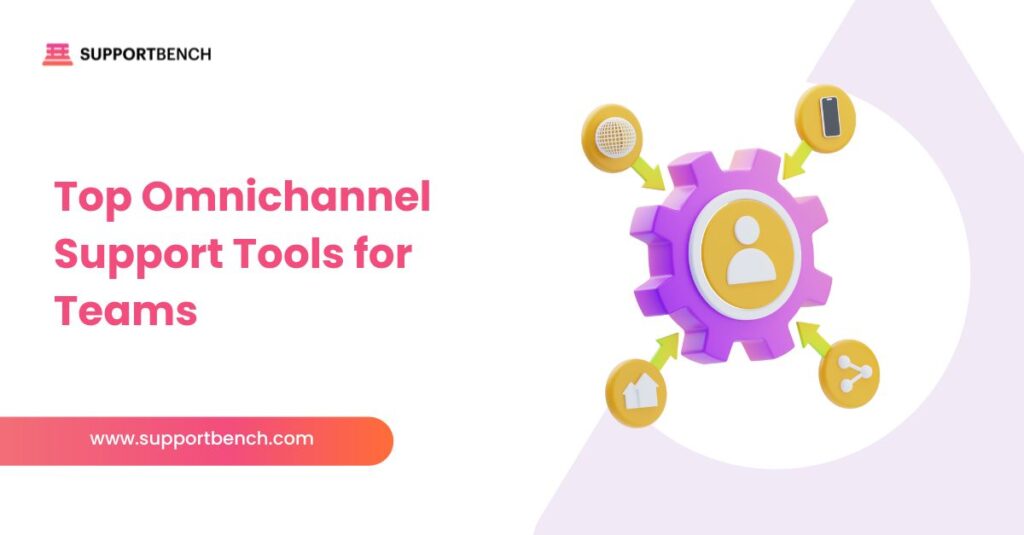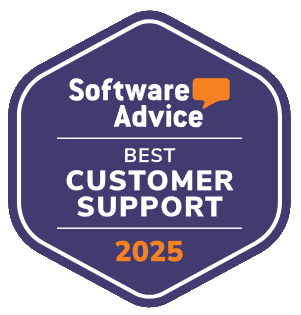Customer expectations are higher than ever, with people seeking quick, consistent, and personalized support across multiple communication channels, such as email, chat, phone, and social media.
Omnichannel support tools provide businesses with a unified platform to manage these interactions, improving team efficiency, reducing response times, and improving customer satisfaction.
The right omnichannel solution can help your team scale support operations while ensuring a smooth and cohesive customer experience across all touchpoints.
At a Glance:
Omnichannel support tools streamline customer service by integrating communication channels like email, chat, and social media into a unified platform. Key features include AI-driven automation, SLA management, and workflow customization. Supportbench excels with advanced integration, scalable architecture, and powerful reporting, making it an ideal solution for businesses seeking to improve efficiency and customer satisfaction.
What is omnichannel communication in customer support?

Omnichannel communication in customer support refers to managing interactions across various touchpoints, including email, live chat, phone, social media, and more, through a unified platform.
Unlike multichannel support, where each channel operates in isolation, omnichannel tools synchronize all communication channels, offering agents a complete view of customer interactions regardless of where or how the customer reached out.
Platforms like Supportbench extend this even further by offering AI-powered customer support workflows, enabling teams to proactively manage service expectations and streamline resolution.
This approach results in faster, more personalized support, where customers don’t need to repeat their issues when switching between channels, and agents can access full context at any time, reducing resolution times and improving satisfaction..
Why Unified Communication Tools Are Essential
Unified communication tools streamline support operations by centralizing all customer interactions into one platform. This leads to several operational advantages:
- Streamlined Operations: Agents manage all interactions within a single interface, reducing the need to switch between different tools.
- Faster Resolution Times: Having full context of customer interactions across multiple channels enables quicker, more accurate responses.
- Centralized Ticketing System: All team members can view the same data, improve collaboration and reduce duplication.
- Smarter Resource Allocation: Analytics help managers track team performance and workload, enabling timely adjustments.
- Stronger SLA Compliance: Automated escalation and SLA tracking ensure urgent issues are addressed within set timelines.
- Scalability Without Friction: As teams grow, unified platforms adapt, supporting additional workflows, roles, and communication channels.
- Improved Customer Satisfaction: Consistent, informed support across all touchpoints builds trust and improves customer loyalty.
What to Look for in a Unified Customer Support Solution

When evaluating omnichannel support tools, several key features are essential for helping businesses scale their customer support operations while improving efficiency. Consider these essential elements:
Centralized Inbox and CRM Integration
A unified inbox consolidates customer messages from all channels, and CRM integration allows agents to access complete customer histories. This enables teams to provide personalized, context-aware support based on accurate customer data, ensuring a seamless customer experience across all touchpoints.
AI and SLA Automation
Automated tools help streamline processes like ticket routing, categorization, and SLA tracking, reducing manual effort and ensuring that urgent cases are prioritized. By automating these repetitive tasks, support teams can focus on more complex issues, improving overall efficiency.
Workflow Automation
Automation tools simplify routine tasks such as ticket assignment, escalation, and notifications. This enhances consistency and scalability, ensuring that workflows remain smooth and manageable even as your team grows or the volume of support requests increases.
Automation Tools to Streamline Omnichannel Support
Automation tools, such as ticket routing and response automation, play a critical role in streamlining omnichannel support. These tools ensure that tickets are automatically routed to the right agents, improving response times and reducing the chances of missed or delayed interactions.
Knowledge Base Integration
An integrated knowledge base allows customers to solve issues independently, reducing the burden on support teams. A well-organized knowledge base helps customers find answers quickly and improves self-service rates, allowing agents to focus on more complex inquiries.
Analytics and Reporting
Comprehensive analytics dashboards offer valuable insights into key metrics, including ticket trends, agent performance, and channel usage. Customizable reports give managers a clearer picture of team performance, helping identify areas for improvement and ensuring that the support team is consistently meeting its goals.
Customization and Flexibility
No two teams work the same. Look for tools that allow you to configure workflows, user roles, ticket views, and branding. Customizing your omnichannel support system guarantees the platform fits your exact operational needs.
Side-by-Side Comparison of Top Omnichannel Support Tools
With numerous platforms available, choosing the best tool can be challenging. Below is a comparison of key features across leading omnichannel platforms:
Feature / Platform | Supportbench | Zendesk | Freshdesk | Salesforce Service Cloud | Helpscout | Front |
| Omnichannel Support | Yes | Yes | Yes | Yes | Limited* | Yes |
AI-Driven Automation | Advanced AI | Add-On | Basic | Native AI Tools | None | Limited |
| SLA Management and Escalation | Dynamic | Basic | Configurable | Robust | Limited | Basic Rules |
Workflow Automation | Deep Customization | Standard | Moderate | Advanced | Limited | Basic |
| Knowledge Base Integration | Built-In & Smart | Yes | Yes | Yes | Yes | Basic FAQ Only |
Analytics and Reporting | Custom Dashboards | Pre-Built | Pre-Built | Advanced | High-Level | Channel Stats |
| Customisation and Flexibility | Fully Customizable | Rigid Structure | Moderate | Developer-Heavy | Minimal | Front-End Focused |
Note: “Limited” indicates the feature exists in a reduced or inflexible form, often requiring workarounds or third-party integrations.
This comparison highlights the strengths and limitations of each platform. While many offer basic omnichannel support, platforms like Supportbench provide a comprehensive, customizable, and scalable solution that is particularly suitable for teams looking to grow without compromising performance.
Choosing the Right Omnichannel Tool by Business Type and Industry
The right omnichannel tool depends on your team’s size, industry, and operational needs. Here are some key considerations:
Startups and Small Teams
Look for tools that are easy to implement and affordable, with essential features such as email, live chat, and a unified inbox. These features enable streamlined communication, allowing small teams to handle customer support efficiently.
Scaling Mid-Market Operations
Choose platforms that provide more advanced features, such as automated ticket routing, knowledge base integration, and process automation. These tools are crucial for handling higher ticket volumes and increasing operational complexity as the business grows.
Complex Industries with Custom Workflows
Industries like healthcare or B2B SaaS need platforms that support custom workflows, regulatory compliance, and detailed reporting. These tools ensure that teams can manage industry-specific requirements while maintaining efficient and accurate support processes.
Enterprise-Scale Organizations
For larger organizations, select platforms with robust CRM integration, advanced reporting capabilities, and the scalability to manage large teams and high-ticket volumes. These features enable seamless support operations across extensive, multi-department teams.
Why Supportbench Stands Out
Supportbench offers several key features that make it an exceptional choice for omnichannel support:
Seamless Integration Across Channels
Supportbench integrates email, chat, phone, and social media into one unified interface. This eliminates the need for platform-switching, ensuring context-aware and efficient support across all communication channels.
AI-Driven Automation for Efficiency
AI-powered automation in Supportbench helps streamline support processes by automating repetitive tasks such as ticket routing, categorization, and SLA management, allowing agents to focus on complex issues.
Powerful SLA and Workflow Customization
Supportbench enables teams to fully customize SLA tracking and workflows according to their specific business needs. This ensures a consistent, efficient, and responsive support process tailored to each organization.
CRM and Tool Integration
Supportbench’s deep CRM integration provides agents with full customer profiles, enabling personalized, context-aware service. This improves both response times and service quality by providing a comprehensive view of each customer.
Scalable, Future-Ready Architecture
Supportbench’s platform is built to scale effortlessly with your business. As your team grows, it supports additional agents, workflows, and communication channels, ensuring seamless expansion with no service disruptions.
Client Success Story: Wolseley Canada Scales Smarter with Supportbench
Wolseley Canada, a leading distributor with a high volume of daily customer inquiries, faced mounting challenges in managing communications efficiently. With a small team fielding 7,000 to 8,000 emails per day, agents were overwhelmed by manual follow-ups and had little visibility into ticket status or team performance.
The result? Delayed responses, unresolved issues, and difficulty reporting on outcomes—especially when communicating with senior leadership.
The Shift with Supportbench
After implementing Supportbench, Wolseley’s support team gained a centralized, intuitive platform that streamlined their entire operation.
✔ Email volume handled increased to over 11,000 per day
✔ Automated workflows reduced manual tracking and follow-ups
✔ Built-in analytics provided immediate visibility into performance
✔ Agents were empowered to focus on resolving issues, not chasing updates
Supportbench’s combination of a unified inbox, built-in knowledge base, and easy-to-navigate interface helped the team regain control—and rebuild customer trust. What once felt overwhelming became manageable, scalable, and trackable.
The simplicity of the platform, paired with powerful automation and reporting, transformed how Wolseley’s team worked and how their customers felt. 1
Decision-Making Framework: How to Choose the Right Omnichannel Support Tool
Choosing the right platform starts with understanding your team’s needs and future goals. This decision-making framework is designed to help you evaluate tools with clarity, based on their operations, scalability, and long-term fit.
1. Define Your Support Team’s Core Needs
Start by identifying the essential functions your team must support:
- Which channels matter most (email, chat, phone, social, SMS)?
- What’s your current and projected ticket volume?
- Do you need features like AI automation or SLA tracking?
Understanding these needs helps filter out tools that lack critical functionality.
2. Evaluate Scalability and Customization
Your platform should grow with you. Look for tools that offer:
- Customizable workflows and routing
- Flexible ticketing logic and permissions
- Support for multi-department and cross-functional collaboration
- Options for interface customization and user roles
3. Prioritize Knowledge Management and Self-Service
Reducing repetitive tickets improves efficiency. Look for platforms that support creating a scalable knowledge base with:
- Easy authoring and updating
- Smart search and internal access
- Self-service portals for customers
4. Check CRM Integration and Data Sync
Your support platform should work in sync with your CRM and other business systems:
- Real-time data sync with contact and ticket history
- Single customer view for all team members
- API or native integrations with key tools
5. Assess Reporting and Analytics Capabilities
Insights drive improvement. Make sure your platform offers:
- Customizable dashboards and KPIs
- Agent performance metrics and ticket trends
- Real-time alerts and exportable reports
6. Consider Usability and Support Resources
Adoption depends on usability. Evaluate:
- Interface simplicity for agents and admins
- Onboarding materials and training tools
- Access to responsive customer support
7. Review Pricing Structure and ROI
Ensure pricing aligns with value delivered:
- Transparent and scalable pricing tiers
- Features that reduce manual workload and increase resolution speed
- Reporting tools that help measure ROI across departments
This framework is more than just a checklist; it’s a way to assess how well a platform will fit your needs now and as your team grows.
Conclusion
The right omnichannel support tool not only streamlines operations but also delivers a consistent, efficient customer experience. A platform that integrates communication channels, automates workflows, and scales with your team can enhance response times and boost customer satisfaction.
Supportbench is a strong example of such a platform, offering flexibility, deep customization, and powerful automation features to meet the growing demands of support teams.
Book a demo today to find out how Supportbench can streamline your customer support operations and help you manage omnichannel interactions more efficiently.















